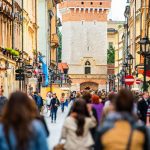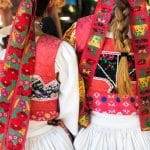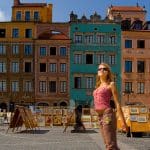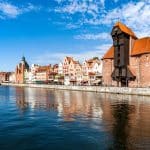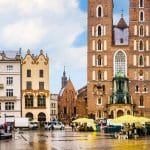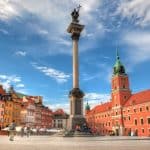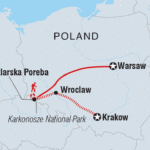Highlights of Southern Poland
Turn the pages of Poland’s story on this seven-day adventure, experiencing the heart and heritage in this captivating country. Admire the revived Jewish Quarter of Krakow, tour the classical architecture of Wroclaw, breathe the fresh air of Szklarska Poreba and finish in the cosmopolitan capital of Warsaw. Much like a good pierogi dumpling, the best bits of the country are found beneath the surface – with a local leader to guide the way, you’ll discover a side of Poland few get to see.
7 days, from
$1,865
per person
GROUP SIZE
ACTIVITY LEVEL
Details
Countries Visited:
Poland
Accommodation: Hotel (6 nights)
Transportation: Train , Local bus , Private vehicle
Included Meals:
- 6 breakfasts
- 1 dinners
Group size: Minimum 1, Max 12
Minimum Age: 15
Discover the Orwellian neighbourhood of Nowa Huta – an alternative district in Krakow that showcases the communist influence in Poland.
Explore Warsaw, a modern city with Gothic, neoclassical and Soviet-era architecture, and a soul of rich history and culture.
Tuck into a Polish food tour, discovering the signature cuisine of this central European country, and wash it all down with a vodka tasting.
Cycle through Gdansk on a bike tour, learning about the city’s history of oppositionist movements, and hear stories of how this important trading port has played a key part in Poland’s history.
Take a sobering walk through the Nazi concentration camp in Auschwitz and Birkenau, joining a local guide to learn about WWII and Europe’s darkest days.
Itinerary
Czesc! Welcome to Poland. You will have an important welcome meeting at 6 pm, meeting your group leader and fellow travellers. Krakow is striking with contrasts: a medieval old town with a large youthful influence, renowned fine dining restaurants with food truck and casual riverside eateries, a vibrant Jewish quarter with some elegant speakeasies and hidden bars. If you would like to spend more time here, why not arrive a little early? After your important meeting, you'll have an option to head out with your group to dinner – your leader will know of some great options.
This morning, begin getting to know Krakow from its relatively new history. Take a guided tour of Nowa Huta – a former communist town turned eastern Quarter of Krakow. Nowa Huta was prime Polish agricultural land but was swallowed up by the Soviet Union in an attempt to create an Orwellian settlement in contrast to the fairytale of central Krakow. An experienced tour guide will explain all the history hidden in its streets and buildings that otherwise would look like another sector of the city. In the afternoon, take a leader-led walk around the Old Town. Rynek (main square) is one of the oldest and most recognisable medieval squares in Europe. With the renaissance Cloth Hall in its centre, now home to the main market, touring the main square is a must. Later on, walk over to Jewish quarter and learn more about that part of town and enjoy a treat of Zapiekanka (Polish pizza) here where the best is made.
This morning leave Krakow behind and visit the former Nazi concentration camp in Auschwitz and Birkenau, where you can learn more about WWII and Europe's darkest days. A walk through the camp with a local guide is a truly sobering experience and helps to understand the sheer scale of the tragic loss of life that occurred here. Late afternoon, return to Krakow and travel on a high-speed train to Warsaw early evening, taking approximately 3 hours. Poland’s capital has a rich history shown in its mix of Gothic, neoclassical and Soviet-era architecture, and also a new, cosmopolitan touch. After arrival, why not head out to a local bar to sample Warsaw’s fantastic selection of craft beers.
Enjoy a morning to discover the wonders of Warsaw. From many options, one worth considering is a visit to the Uprising Museum. Dedicated to the Warsaw Uprising in 1944, the museum is a tribute for residents who fought and died for an independent Poland, and a free capital. It was said that Warsaw survived its own death – learn about that part of history of this city in one of the most modern museums in Europe. Otherwise, sit back in one of the many parks, stroll past the Tamka street art or take a walk along the delightful banks of the Vistula River. This afternoon head out on a guided tour all about Polish cuisine. Being one of the lesser-known European foods, you’ll learn about Poland’s signature dishes. To wash everything down, you’ll even get the chance to test out some local vodka with an included tasting. Na zdrowie!
Travel onwards to Gdansk aboard a high-speed train (approximately 3 hours). This seaside city delivers in both eclectic charm and multilayered history. Settle in to your hotel then head out with your leader to get to know Gdansk with a walk around the charming Old Town, passing by rows of tall, colourful buildings. In the evening, perhaps head out for a traditional Polish meal at Tawerna Mestwin, serving specialties of Kashubian regional cooking (north Poland cuisine). Interiors of this place look like a traditional farm cottage and the exposed beams and dark-green walls make for a cosy atmosphere.
Today, head out on a bicycle tour around Gdansk. This will include a visit to most iconic sites of the city: the Crane (Zuraw), an iconic trading symbol located near the National Maritime Museum. Visit Olowianka, an island in the middle of the Motlawa River, to learn more about Gdansk’s maritime history. Then cycle to the Gdansk Shipyards, famous for being the place where the Solidarity trade union was formed in 1980. Following the bike ride take your time to visit the excellent European Solidarity Centre, a museum that tells the story of the union and civil resistance that took place to push for workers’ rights, a movement that contributed to the later fall of the Berlin Wall. This afternoon, hop aboard a public bus and travel to the peninsula of Westerplatte, the site of the Battle of Westerplatte between German and Polish forces, marking the beginning of WWII. Visit the Westerplatte Monument which stands in memory of the Polish defenders and learn about the brutal battle that took place over a week in 1939. Return to Gdansk for the evening and perhaps take a walk down Dlugi Targ to find a spot for dinner – it’s a lot quieter at night than during the day.
Your adventure comes to an end after breakfast this morning. If you’d like to extend your stay in Gdansk, just get in touch ahead of time and we’d be happy to arrange additional accommodation (subject to availability).
